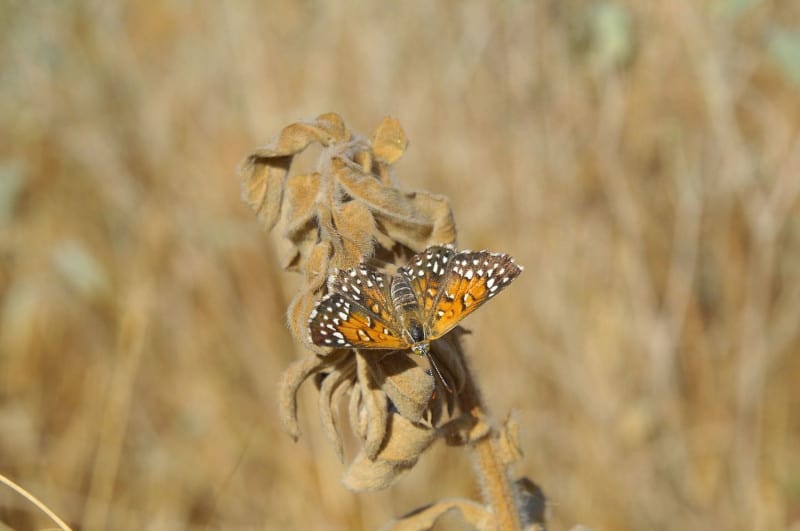Lange’s Metalmark Butterfly Facts
- Unfortunately, for all of its many special and fascinating qualities, the magnificent Lange’s Metalmark Butterfly remains best known for a very sad reason. This little Lepidoptera currently holds a lamentable position among similar insects.
- The stunning insect ranks as the fourth rarest of all known varieties of butterflies in the world. In point of fact, the most recent estimates place the surviving population of the uniquely charming arthropod at no more than 450 individuals.
- Interestingly, a remarkable fact quickly became evident when Dr. John A. Comstock discovered the beautiful invertebrate in 1933. He found the marvel in one highly isolated region, and it has never been seen elsewhere.
- In addition, the amazing creature also represents a subspecies of another beautiful butterfly, the Mormon metalmark. Due to its official status as a subspecies, the IUCN does not list the Lange’s Metalmark Butterfly on its Red List.
- The butterfly presently holds the understandable status of Endangered in the country in which it appears, however. Quite thankfully for those who respect Nature, concerted conservation efforts remain underway at this time.
- But its own nature tends to limit these attempts to preserve it. For unknown reasons, the butterfly evolved a complete dependency upon on specific plant. Captive breeding has been ongoing since 2007, but few released individuals survive.
Related Articles
Lange’s Metalmark Butterfly Physical Description
Although it does stand out for its many other fabulous qualities, the beautiful Lange’s Metalmark Butterfly does not impress one due to its size. The marvelous insect elegantly proves the old adage that beauty comes in all shapes and sizes.
This stunning arthropod remains quite small in dimensions, at least compared to other butterfly species around the world. But this petite animal does distinguish itself from many others of its kind in that it displays no noticeable degree of sexual dimorphism.
Due to this uncommon fact, mature adults of both genders of the remarkable invertebrate attain the same average wingspan. Further, these quite delicate appendages have an average width measuring between 1 – 1.5 in (2.54 – 3.81 cm).
In addition, both genders of this species display the same overall physical appearance, beyond the simple matter of the wings. This includes both the overall coloring, and the patterns in which these appear. Obviously, this complicates identification of the sexes.
Firstly, the dorsal wings present as principally black, with numerous small, white spots. Meanwhile, reddish-orange coloring runs through much of the interior of these. But the underside of the wings displays a lighter blend of black, gray, orange, and white.
- Kingdom: Animalia
- Phylum: Arthropoda
- Class: Insecta
- Order: Lepidoptera
- Family: Riodinidae
- Genus: Apodemia
- Species: A. mormo
- Subspecies: A. m. langei
Lange’s Metalmark Butterfly Distribution, Habitat, and Ecology
Quite sadly, the astonishing Lange’s Metalmark Butterfly inhabits one of the smallest ranges of any known Lepidoptera. To be more precise, this creature only appears in a perilously small portion of the Antioch Dunes National Wildlife Refuge.
This sits about 40 mi (64 km) from the city of San Francisco, in the United States. More precisely, this tiny refuge in North America only comprises an area of 67 acres (27 hectares). But, even there the little beauty inhabits an especially specific and restrictive habitat.
The invertebrate only appears to live along the southern banks of one small stretch of the Sacramento River. Its former range once included a more extensive stretch of the same river. Surprisingly though, no evidence of a formerly greater range exists.
Originally, this area consisted of a somewhat surprising type of environment. That was largely formed of numerous and comparatively extensive sand dunes. However, this landscape changed dramatically and rapidly when human expansion into the region began.
That was due to the fact that humans subsequently removed most of the sand for construction purposes. This removal led to the alteration of the available dune habitat to its current condition of primarily scrubland, with many small hills.
The gorgeous Lange’s Metalmark Butterfly has a lifespan averaging about one year. However,only a small portion of that period of time consists of adulthood. The species remains completely dependent on the presence of a shrub known as the Naked Buckwheat.
For reasons that still mystify researchers, the females will only lay eggs on the leaves of this plant, and nowhere else. If the plant isn’t present, no eggs are laid. Larvae fed only on this plant, but adults will also feed on nectar from a few other local plants.
Species Sharing Its Range
Check out our other articles on 5 Incredible South American Islands, Vietnamese Mossy Frog, Mount Erebus, Golden Armadillo Lizard, Monkey Puzzle Tree, Goldsmith Beetle, Rock Hyrax

